by David M. Miller
The Claiming Crown is three years out of the gate, and the returns on this year’s running suggest that while it has found a permanent place on the racing calendar, determining how and where it should be hosted in the years to come remains an unanswered question. The problems facing the management of the Claiming Crown could be likened to a trainer contemplating the next race for a winning horse: where should we run next?
The concept of the Claiming Crown was originally proposed by former Thoroughbred Owners and Breeders Association (TOBA) head Drew Couto, who discussed a joint sponsorship of the event with Bill Walmsley of the National HBPA. Original plans for the event called for the participation of the Birmingham Turf Club and a pool of simulcast monies that had accrued in the Alabama horsemen’s account. When certain administrative restrictions prevented that plan from being implemented, the Claiming Crown was in jeopardy of ever coming to fruition. Following a contact from Randy Sampson, the president and general manager of Canterbury Park, negotiations for hosting the Claiming Crown began in earnest. A series of starter handicap events for runners who had raced for claiming tags from $5,000 to $25,000, with a collective purse structure of $550,000, began to take shape, and a formal announcement of the Claiming Crown was made in February 1999. The following August, the first Claiming Crown was held and, despite limited simulcasting distribution, the Claiming Crown proved an unqualified success, with Canterbury Park posting record live attendance and handle numbers.
Located in Shakopee, Minnesota, Canterbury Park has now been host to the Claiming Crown for its first three runnings. Preparations for this year’s event began at the National HBPA convention in San Antonio, Texas in January, when event organizers announced some significant changes to the Claiming Crown format. The first change announced was the decision to revert to a six-race schedule, deleting the mile and sixteenth turf Tiara for fillies and mares. The reduction of the race allowed for higher purses for the other Claiming Crown races.
Perhaps the most significant format change was the change in eligibility that allowed runners with just one start for a specified claiming price to compete in the Claiming Crown. The starter handicap weights were also reduced to a maximum of 124 pounds from the previous limit of 126 pounds.
Horsemen were required to nominate their charges using one of two methods. A regular nomination for the Claiming Crown could be secured for $100, requiring the nominator to name the desired runner prior to May 1, 2001. Horsemen could also make “open” nominations for $250 until May 1, leaving themselves the option to name their entrant by June 15. Regular nominations could also be made from May 2 through June 15 for a $500 fee. While nominators were required to identify their intended runners by June 15, they did not need to specify in which race they would compete.
Part of the original budget overrun in the first year’s running of the Claiming Crown was due to a shortfall in the predicted number of Claiming Crown nominations. Despite a more concentrated effort in 2000, nominations still fell short of projections. Canterbury Park Director of Live Racing Nat Wess took on an added role as the event’s coordinator when spearheading an effort to increase the number of nominations for the Claiming Crown this year. Using the previous year’s number of 177 nominations as a baseline, Wess set out to secure 200 nominations for the event. Wess noted that in recruiting stops at tracks around the country, horsemen had become familiar with the concept of the Claiming Crown.
“The big difference I noticed from the first year I went (to various racetracks) … is that the that Claiming Crown didn’t have to be explained to everybody,” Wess explained. The second year I went around, when I said I was with the Claiming Crown, everyone said ‘Oh yeah, I know that day in Minnesota … I’ve got a horse I’ve been thinking about for that.’ People were much more aware about it this year. It was much easier to do this job this year.”
Wess revealed that part of his strategy in recruiting horses for the Claiming Crown involved scouting for probable candidates in daily past performances at tracks around the country. When he found a runner with a good fit for the Claiming Crown conditions, he would send a copy of the horse’s past performance, along with a letter, to the runner’s connections inviting them to nominate. While Wess also noted that the change in eligibility rules must have helped increase the number of nominations, his indefatigable efforts as Claiming Crown recruiter and coordinator brought about a record 244 nominations.
Following a trend that began in 2000 at Philadelphia Park, a number racetracks were hosts to Claiming Crown “Preview” race days. Runners that won these events at Lone Star at Grand Prairie, Prairie Meadows, Turf Paradise and Philadelphia Park each automatically qualified for a starting stall in their respective Claiming Crown event. The winners of the prep races at Lone Star were each given an additional $2,000 by the Texas Horsemen’s Partnership, LLP, to help defray shipping expenses to the Claiming Crown.
Pre-Entries for the Claiming Crown were taken on July 20, at which time horsemen were required to declare which race the nominees intended to enter, while also allowing connections the opportunity to enter in two of the Claiming Crown events. When the pre-entries were released, the depth of the competition in this year’s event was revealed as four of the races were oversubscribed. Following a system prescribed in the original rules of the Claiming Crown, runners were ranked according to a point system that would determine which competitors had the best form. Runners who had won a Claiming Crown prep race and the two highest ranked horses stabled at the host track were also guaranteed positions in the starting gate. Final entries were drawn on Wednesday, August 1, following a breakfast held for the Claiming Crown participants in the Canterbury Park clubhouse.
A protracted heat wave had enveloped Minnesota during the days leading up to the Claiming Crown Day. The event was contested under hazy conditions, with the temperatures in the mid-90s.
The 3-M Vet Wrap Iron Horse

Following the late declaration of Western Warren, 13 runners entered the gate for the Claiming Crown Iron Horse, a $50,000 event for runners that had started at least once for a claiming tag of $5,000 in the previous year. The race was sponsored by 3-M Vetwrap.
Trainer Scott Lake fielded an uncoupled entry in the mile and a sixteenth event: favored Bellwether had won four races for owner Richard Besecker since being claimed for $18,500 in February, while Richard Englander’s Slew Can Go had captured five races this year. Demonstrating the depth of this year’s Claiming Crown entrants, three other runners in the field had captured five wins in 2001.
Saving plenty of ground and making a strong move late under jockey Luis Quinonoez was Secret Squall, who bested late-running Home A Winner at the wire by a length and a half. Gotthard finished third, another three parts of length behind.
Owned by Minnesotans Chris West and John Mentz, Secret Squall was lost by his current connections to owner Richard Englander last year via the claim box, but he was reclaimed at Arlington Park in June. Trainer Pat Cuccurullo revealed in the winner’s circle that after he claimed the horse from Leo Gabriel, he told the rival trainer about his plans to ship to Canterbury. “I told Gabriel we were going to run him in the Claiming Crown, and he told me I was nuts,” said Cuccurullo. “I told him I’d send him a win picture, and he said ‘I’ll never see it.’”
The Kentucky-bred son of Summer Squall earned $27,500 for his victory in the Iron Horse.
The Winticket.com Express
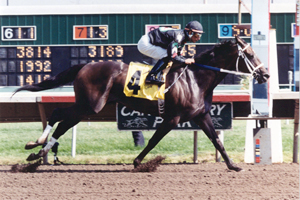
The $50,000 Claiming Crown Express, for runners that had started once for $7,500 in the previous year, was sponsored by the Internet wagering site Winticket.com. The six furlong contest featured only 10 runners, and the past performances of the heavily favored The Maccabee revealed why. Along the with a five race win record for the year, the rapidly improving Pennsylvania-bred sported two gaudy triple digit Beyer numbers in his last two victories.
Sent postward at 3-to-10 odds, The Maccabee dispensed with the formalities and cruised to a handy nine-and-a-quarter length win over second choice Lord of Time, who in turn bested Hot Affair by a little more than a length. Setting fractions of :21 3/5 and :44 1/5 under jockey Jose Flores, The Maccabee was never fully extended while completing the six furlongs in 1:09 3/5.
Trainer Scott Lake claimed the five year old from breeder Norris Gelman at Philadelphia Park in January for the Leo Gaspari Racing Stable. The Maccabee earned $27,500 for his triumph in the Express.
The Glass Slipper
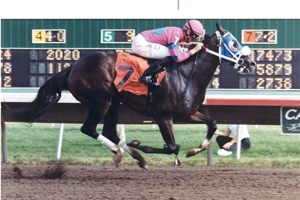
Fourteen runners were entered in the $75,000 Claiming Crown Glass Slipper for fillies and mares that had started for a claiming tag of $12,500 or less in the previous year. That number was reduced by one with the scratch of Lovely Navita.
The six and a half furlong contest featured several talented fillies, including favored Lady Di Huntley. However, it was the other half of the uncoupled Scott Lake entry that came through for the trainer. Anthony Centurione’s French Teacher broke sharply and led by daylight at every call to win the Glass Slipper by six and a half lengths while stopping the timer in 1:16 3/5. Beauty’s Due gave trainer Stanley Roberts his second longshot placing of the day when she came home clearly best of the remaining field, two and half lengths in front of Lost Judgement.
The winner was ridden by Mark Johnston and was claimed by her current connections for $15,000 at The Meadowlands in September. The Kentucky-bred daughter of Robin des Pins earned $41,250 for her win in the Glass Slipper.
The Rapid Transit
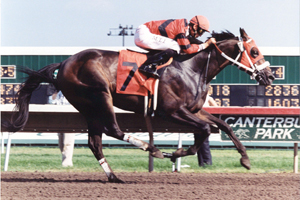
The $100,000 Claiming Crown Rapid Transit featured 13 runners that had started for a claiming price of $16,000 in the previous year. Trainer Ben Feliciano Jr. had secured the services of rider Mark Johnston for the event after seeing that the Maryland based rider would not be aboard favored Sonofaqueen. Johnston had been at the helm when Sonofaqueen bested Feliciano’s charge, Sassy Hound, in an optional claiming event in January at Laurel, and the trainer decided Johnston could be an important variable when trying to turn the tables. The strategy paid off when Sassy Hound took command in upper stretch and drew off to a four and three quarter length victory over Crowns Runner, completing the six and a half furlongs in 1:16 3/5. Locally based Exert, the longest price on the board at 123-to-1, made a late run in traffic to be third, another length and a half behind.
Claimed at Laurel by owner Toby Roth for $14,500 in January of 2000, Sassy Hound earned $55,000 for his victory in the Rapid Transit. The Maryland-bred son of Deerhound has won nine of 17 career starts and earned over $219,000.
The Emerald
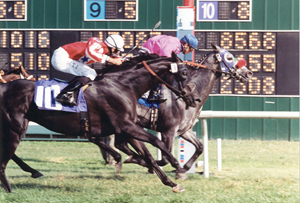
The $125,000 Claiming Crown Emerald, for runners that had started for $20,000 in the previous year, was the only turf race carded as part of this year’s Claiming Crown. Owner James Jackson and trainer Dallas Keen were represented by Dignitas Dancer, who was heavily favored off his close second place finish in the Dallas Turf Cup.
Following a rough break where the favorite clipped heels with another rival, a pace duel ensued. Making the most of an inside trip was Al’s Dearly Bred, who found room along the rail in time to best late-running Metatonia by a head.
The winner was claimed in his career debut in February of 2000 at Gulfstream Park, but he had only found his best form in the months preceding this year’s running of the Claiming Crown. A Kentucky-bred son of Waquoit, Al’s Dearly Bred had been dropped into a $10,000 non-winners of two lifetime event in March at Hialeah. Then, he improved markedly when tried over the grass course this spring.
The winner exited perhaps the strongest race of any runner in the field after finishing a non-threatening ninth in the Stars & Stripes Breeders’ Cup Handicap (Gr. IIT) at Arlington Park in his last start. The winner is trained by Hugh Robertson and was ridden to victory by Seth Martinez, who joined the Canterbury Park jockey colony this year.
Al’s Dearly Bred’s owner John Castro hails from Minnesota but campaigns the majority of his stock with other Robertson runners in Chicago. The winning connections earned $68,750 for their victory in the Emerald.
The Jewel
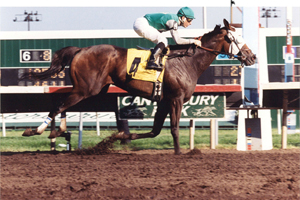
The $150,000 Claiming Crown Jewel, run under starter handicap conditions for horses that had started for a claiming tag of $25,000 or less in the last year, drew the shortest field of the day with eight runners. Richard Englander, who leads all owners in the country by numbers of wins, had made 40 nominations to this year’s Claiming Crown. Four of the Englander colorbearers had been entered in the Claiming Crown, but none of his three prior starters on the had won their respective heats. The day’s success now rode solely on one horse: 6-to-5 favorite Sing Because.
Stalking a solid tempo set by pace-pressing Five Straight and Power of Humor, the eight-year-old gelding accelerated on command midway through the far turn and took over from Five Straight nearing upper stretch. Under rider Jose Valdivia Jr., Sing Because drew off in the lane to win the mile and an eighth Jewel from 40-to-1 longshot Halo Kris by three and a half lengths. Banner Salute made some late progress to finish third another three and three quarters lengths behind Halo Kris.
Claimed in May for $40,000 at Hollywood Park by trainer Nick Canani, Sing Because was making his second start in the familiar Englander silks. The connections had campaigned Sing Because for several months in 1999 before losing him through the claim box.
The $82,500 winner’s share of the Jewel purse brings Sing Because’s career earnings to over $354,000. A winner of 11 races from 37 lifetime starts, Sing Because was bred in Kentucky by Charlie Whittingham and William Seabaugh.
Mixed Results
Canterbury officials were left with mixed feelings over the success of Claiming Crown III. This year’s Claiming Crown fields were by far the most competitive ever, and the displays by each race’s respective winners were some of the most scintillating performances witnessed at Canterbury Park in several years. Simulcast bettors responded with enthusiasm to the complex handicapping challenge that the Claiming Crown represents, and their presence was felt in a significant increase in off-track handle.
A better than 80% increase in total off-track handle was registered in this year’s Claiming Crown, with $2,547,646 wagered at 450 simulcast outlets throughout North America. The increase in off-track handle for the Claiming Crown is attributable in large part to expanded presentation to simulcast markets not previously exposed to the event. In previous years, the Claiming Crown was not simulcast in its entirety in New York, and last year, the tracks that comprise the Mid-Atlantic consortium elected not to simulcast the Claiming Crown.
Another factor that must be considered is the expanded coverage the Claiming Crown received in the pages of Daily Racing Form. Midwest correspondent Marty McGee was on hand most of the week and filed stories describing the event in the days leading up to the Claiming Crown. Daily Racing Form’s Simulcast Weekly publication featured a cover story describing the excellent value bettors could find in wagering on the Claiming Crown races. Given sufficient notice and a similar treatment by the racing media in years to come, the simulcast market should be a strong supporter of the Claiming Crown concept.
Despite the 30% increase in all-sources handle, Canterbury Park President and General Manager Randy Sampson admitted some disappointment when discussing significant drops in live attendance and handle. This year’s attendance of 8,078 was a far cry from last year’s 13,922, and the live handle took a similar dip, down to $612,252 from the previous total of $999,719.
In a week where heat stroke claimed the life of Minnesota Vikings Pro Bowler Korey Stringer, it was understandable that the oppressive temperatures found on Claiming Crown day would depress attendance. This year’s NTRA “Mystery Mutuel Voucher” promotion was not held in conjunction with the Claiming Crown (it was in 2000), and that lack of cross-promotion certainly had some impact on Canterbury’s live handle count.
Canterbury Park’s three-year quest to make the Claiming Crown a profitable experience for the host racetrack should give event organizers some pause as the next site for the Claiming Crown is debated. Canterbury Park and the Minnesota HBPA were instrumental in creating the Claiming Crown, and each organization has made significant financial sacrifices to supplement the production of each renewal of the Claiming Crown. In its first two years of hosting the event, Canterbury Park officials acknowledge that approximately $300,000 was sacrificed in establishing the Claiming Crown. Canterbury officials had hoped that this year’s event would at least pay for itself, but they won’t know if they were successful in their attempt until accounting reports for each department are tallied later in the year.
After three years, nearly every racing jurisdiction in North America has been represented in the three runnings of the Claiming Crown, and the concept of a championship for the everyday owner and his horse has taken a firm hold on the racing calendar and the racing community at large. Canterbury Park’s example for future host sites suggests that it will take an organization with resolve and solid planning to help the Claiming Crown achieve continued success.
© 2001 The Horsemen’s Journal
